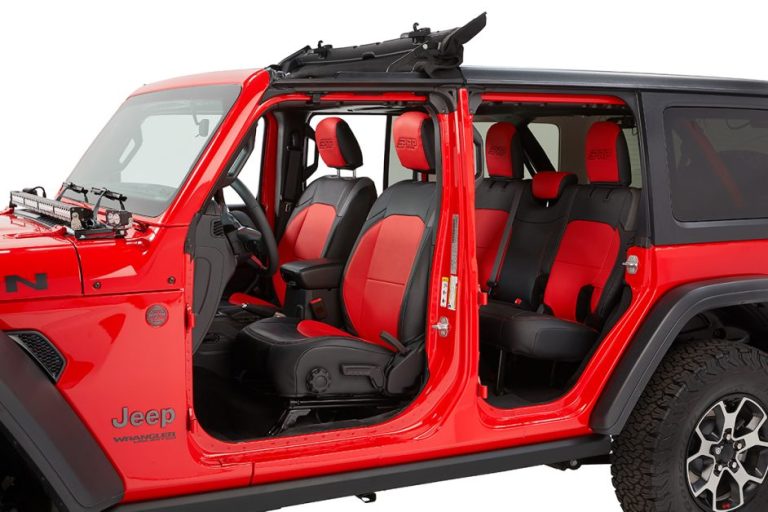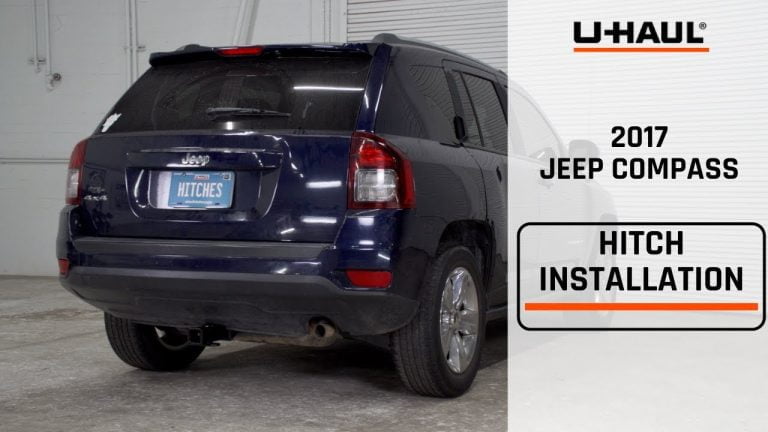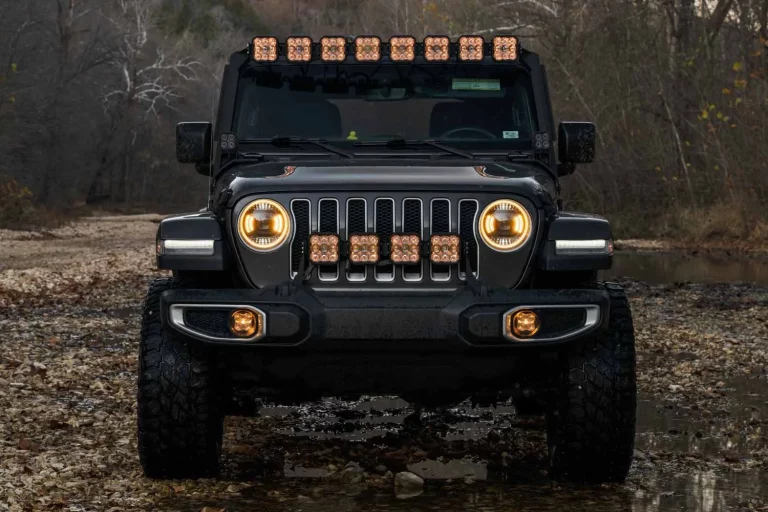How to Modify a Jeep? Enhance Performance and Aesthetics
Jeep Wranglers are renowned for their off-road prowess, but did you know that with a few modifications, you can take your adventure to the next level?
From increasing power and drivability to improving off-road capabilities, this article will delve into the world of Jeep modification.
Buckle up, because we’re about to explore the exciting possibilities of adding larger tires, re-gearing the axles, lifting the Jeep, and enhancing durability with aftermarket parts.
Get ready to transform your Jeep into the ultimate off-road machine!
how to modify a jeep
To modify a Jeep, there are several options to consider.
However, it is important to note that adding very large tires to a Jeep Wrangler can decrease its power and drivability.
Jeeps are designed to work well with 33-inch tires, and increasing tire size can decrease the mechanical advantage and add weight and rolling resistance.
To regain lost power, the axles can be regeared.
The ideal axle gear ratio can be calculated using the formula RPM = 336 x (Final Drive Ratio X MPG) / (Tire Loaded Radius x 2).
Generally, 4.10 axle gears are ideal for tires around 35- or 37-inches, while shorter 5.13 gears are recommended for tires larger than 38 inches.
It is also possible to improve the off-road capabilities of a Jeep Wrangler with aftermarket parts.
Replacing the factory differential covers with heavier alternatives can protect the underbody.
Adding 1-2″ of ground clearance can help navigate obstacles, and increasing tire size can also contribute to increased ground clearance.
LED lights, light bars, and spotlights are popular modifications that can improve visibility during off-roading.
Lastly, aftermarket bumpers and fenders can provide higher durability.
Key Points:
- Adding very large tires to a Jeep Wrangler can decrease power and drivability
- Jeeps are designed to work well with 33-inch tires
- Axles can be regeared to regain lost power
- 4.10 axle gears are ideal for tires around 35- or 37-inches
- Aftermarket parts can improve off-road capabilities
- LED lights, light bars, and spotlights can improve visibility during off-roading
- Aftermarket bumpers and fenders can provide higher durability.
Check this out:
💡 Did You Know?
1. The word “Jeep” was originally used as a slang term by U.S. Army mechanics during World War II. It referred to any unproven vehicle or equipment, and eventually became the official name for the iconic 4×4 off-road vehicle.
2. The first Jeep prototype was designed and built in just seven weeks during the early 1940s for military use. It was known as the “Willys Quad,” and later evolved into the Willys MA and MB models.
3. Despite their rugged reputation, Jeeps can be effectively modified for fuel efficiency. Simple modifications like optimizing tire pressure and using a snorkel kit to help the engine breathe better can significantly improve fuel economy.
4. In 1987, American Motors Corporation (AMC) introduced the Jeep Wrangler YJ model, which was the first Wrangler to include square headlights. This controversial change sparked outrage among fans and led to the nickname “Yuppie Jeep” due to its perceived urban appeal.
5. Some Jeep enthusiasts have taken the art of modifying their vehicles to extreme levels. This includes transforming Jeeps into fully functional amphibious machines by adding additional sealing, propellers, and rudders – enabling them to navigate both land and water with ease.
The Impact Of Adding Large Tires To A Jeep Wrangler
When it comes to modifying a Jeep Wrangler, one of the most popular upgrades is adding larger tires. However, it is important to understand that this modification does come with some drawbacks.
One of the main concerns when adding very large tires to a Jeep Wrangler is the decrease in power and drivability. Jeeps are originally designed to work well with 33-inch tires, so anything larger than that may negatively affect the mechanical advantage of the vehicle.
The addition of larger tires also brings the issue of increased weight and rolling resistance. This means that the engine has to work harder to propel the vehicle forward, resulting in a decrease in power. Additionally, the larger tires place more stress on the drivetrain, which can lead to increased wear and tear on components such as the axles and differential.
- Adding larger tires to a Jeep Wrangler may decrease power and drivability.
- Jeeps are originally designed to work well with 33-inch tires.
- Anything larger may negatively affect the mechanical advantage of the vehicle.
- Larger tires increase weight and rolling resistance.
- Increased weight requires the engine to work harder, resulting in decreased power.
- Larger tires place more stress on the drivetrain, leading to increased wear and tear on components such as the axles and differential.
Regaining Lost Power Through Axle Re-Gearing
Adding large tires to a Jeep Wrangler may decrease its power and drivability. However, there is a solution to regain some of the lost power – re-gearing the axles. This process involves changing the gear ratio in the differential, which allows the engine to transfer power more effectively to the wheels.
Benefits of axle re-gearing:
- Restores the original performance of the vehicle
- Improves power and drivability of the Jeep Wrangler
It is important to note that axle re-gearing can be complex and requires technical knowledge. To ensure proper installation, it is recommended to consult with a professional or experienced mechanic. By re-gearing the axles, the negative effects of adding large tires can be minimized, and the Jeep Wrangler can once again perform at its best.
Calculating The Ideal Axle Gear Ratio For Large Tires
Determining the ideal axle gear ratio is crucial when re-gearing the axles. This calculation takes into account the RPM (Revolutions Per Minute), final drive ratio, miles per gallon (MPG), and tire loaded radius.
The formula for calculating the ideal axle gear ratio is as follows:
RPM = 336 x (Final Drive Ratio X MPG) / (Tire Loaded Radius x 2)
To determine the final drive ratio, you can refer to the manufacturer’s specifications or consult with a reputable mechanic. They will provide the necessary information.
The MPG is based on the average fuel economy of the Jeep Wrangler.
To measure the tire loaded radius, measure the distance from the ground to the center of the tire. This will ensure accurate calculations.
In summary, when re-gearing your axles, consider the RPM, final drive ratio, MPG, and tire loaded radius. Calculating the ideal axle gear ratio using the provided formula will help ensure optimal performance.
Now here is the improved text using markdown formatting:
Determining the ideal axle gear ratio is crucial when re-gearing the axles. This calculation takes into account the RPM (Revolutions Per Minute), final drive ratio, miles per gallon (MPG), and tire loaded radius.
The formula for calculating the ideal axle gear ratio is as follows:
RPM = 336 x (Final Drive Ratio X MPG) / (Tire Loaded Radius x 2)
To determine the final drive ratio, you can refer to the manufacturer’s specifications or consult with a reputable mechanic. They will provide the necessary information.
The MPG is based on the average fuel economy of the Jeep Wrangler.
To measure the tire loaded radius, measure the distance from the ground to the center of the tire. This will ensure accurate calculations.
In summary, when re-gearing your axles, consider the RPM, final drive ratio, MPG, and tire loaded radius. Calculating the ideal axle gear ratio using the provided formula will help ensure optimal performance.
- Consider the RPM, final drive ratio, MPG, and tire loaded radius
- Use the formula RPM = 336 x (Final Drive Ratio X MPG) / (Tire Loaded Radius x 2)
- Refer to the manufacturer’s specifications or consult with a reputable mechanic to determine the final drive ratio
- Measure the tire loaded radius by measuring the distance from the ground to the center of the tire.
Recommended Axle Gear Ratios For Different Tire Sizes
When choosing the axle gear ratio for larger tires, there are general recommendations based on tire size. For tires around 35- or 37-inches, 4.10 axle gears are recommended. These gears offer a balance between power and drivability. However, for tires larger than 38 inches, it is often recommended to go with shorter 5.13 gears to ensure optimal performance.
The choice of axle gear ratio ultimately depends on the specific tire size and the intended use of the Jeep Wrangler. It is advisable to consult with a professional or experienced off-road enthusiast to determine the best axle gear ratio for each individual situation.
Enhancing Off-Road Capabilities With Aftermarket Parts
Jeep Wranglers are renowned for their off-road capabilities, and there are many aftermarket parts available to enhance these abilities even further. These modifications not only improve the performance of the vehicle but also add to its aesthetics.
One of the essential upgrades for off-roading is replacing the factory differential covers with heavier alternatives. These heavy-duty differential covers protect the underbody of the Jeep Wrangler from potential damage caused by rocks, tree stumps, and other obstacles.
Another crucial modification is increasing the ground clearance of the vehicle. This can be achieved through various means, such as adding a lift kit or replacing the suspension components. By gaining 1-2 inches of ground clearance, the Jeep Wrangler can navigate obstacles with greater ease.
Protecting The Underbody With Heavy-Duty Differential Covers
When it comes to off-roading, protecting the underbody of a Jeep Wrangler is of utmost importance. The factory differential covers are usually not sufficient to withstand the harsh conditions encountered during off-road adventures. Therefore, replacing them with heavy-duty differential covers is highly recommended.
These aftermarket differential covers are constructed from durable materials such as steel or aluminum, providing enhanced protection against rocks, branches, and other hazards present on off-road trails. By installing heavy-duty differential covers, the vulnerable components of the Jeep’s drivetrain, such as the ring and pinion gears, will be safeguarded, minimizing the risk of costly repairs.
- Upgrading to heavy-duty differential covers is crucial for off-roading in a Jeep Wrangler.
- Aftermarket differential covers are made of sturdy materials like steel or aluminum.
- Provides enhanced protection against rocks, branches, and other hazards on off-road trails.
- Safeguards vulnerable components of the drivetrain, including the ring and pinion gears.
“Replacing the factory differential covers with heavy-duty options is highly recommended for off-road enthusiasts.”
Increasing Ground Clearance For Better Obstacle Navigation
When modifying a Jeep Wrangler, increasing ground clearance is a crucial consideration. It allows the vehicle to tackle more challenging terrain without getting hung up on obstacles. One of the most effective ways to achieve this is by installing a lift kit, which raises the height of the vehicle.
The amount of ground clearance needed depends on the tire size. For 33-inch tires, minimal changes are required, while 35-inch tires usually require a 2.5 to 3-inch lift. It is important to note that the lift should be done correctly to ensure proper alignment and suspension geometry.
By increasing ground clearance, the Jeep Wrangler can navigate rough terrain, overcome larger obstacles, and enjoy an improved off-road experience.
- Lift kit installation is crucial for increasing ground clearance in a Jeep Wrangler.
- Proper alignment and suspension geometry should be considered during the lift installation process.
- The amount of ground clearance needed depends on the tire size.
- For 33-inch tires, minimal changes are required.
- For 35-inch tires, a 2.5 to 3-inch lift is usually recommended.
“Increasing ground clearance allows the Jeep Wrangler to tackle challenging terrain and overcome obstacles.”
Improving Visibility With LED Lights And Other Lighting Modifications
Visibility is crucial when off-roading, especially during nighttime adventures. Adding LED lights and other lighting modifications can significantly enhance visibility and improve safety on the trail.
LED lights have become a popular choice due to their superior brightness and energy efficiency. They provide double the light output of factory headlights, ensuring a clear view of the surroundings. In addition to LED headlights, light bars and spotlights can be added to provide a broader range of illumination and improve visibility in specific areas.
These lighting modifications not only enhance visibility but also enhance the aesthetics of the Jeep Wrangler. They add a rugged and stylish look to the vehicle, making it stand out both on and off the road.
In conclusion, modifying a Jeep Wrangler to enhance performance and aesthetics is a thrilling endeavor. However, it is crucial to consider the impact of adding large tires, the importance of axle re-gearing, and calculating the ideal axle gear ratio for optimal performance. Additionally, aftermarket parts like heavy-duty differential covers, increased ground clearance, and lighting modifications can further enhance the off-road capabilities and aesthetics of the Jeep Wrangler. With the right modifications and careful consideration, a Jeep Wrangler can be transformed into the ultimate off-road machine.
FAQ
Can you modify a Jeep?
Yes, you can definitely modify a Jeep, and one of the most popular upgrades for a Wrangler is changing the wheels and tires. This modification not only enhances the visual appeal of the vehicle, but also greatly affects its performance. By opting for off-roading tires, you can ensure maximum traction and protection, making your Jeep capable of conquering rough terrains with ease. Whether it’s for a better driving experience or an improved off-roading capability, modifying the wheels and tires is a great way to enhance your Jeep Wrangler.
How to make a Jeep look badass?
To make your Jeep look badass, start by upgrading its exterior with custom grilles and bumpers that showcase your personal style. These accessories not only provide added protection but also add a distinct flair to the front end of your vehicle. Additionally, don’t overlook the importance of ensuring comfort and style. Enhance the interior with premium upholstery, high-quality sound systems, and modern technology to create a truly badass driving experience that reflects your unique personality.
Are Jeeps easy to flip?
While Jeeps have a higher center of gravity compared to other vehicles like convertibles or sedans, making them more prone to flipping, it is not accurate to claim that they are inherently easy to flip. Although they can be involved in dramatic and dangerous accidents, factors such as driver behavior, road conditions, and vehicle modifications play a significant role in determining the likelihood of a Jeep flipping. Additionally, driving a Jeep without a top increases the risk, as it affects the vehicle’s stability and can potentially lead to a rollover. However, with proper caution and responsible driving, the risk of a Jeep flipping can be minimized.
How can you modify a jeep to enhance its off-road capabilities?
There are several modifications that can be done to enhance a jeep’s off-road capabilities. One common modification is to install larger and more aggressive tires, which provide better traction and ground clearance. This allows the jeep to navigate through rough terrains more effectively. Another modification is to add a lift kit, which increases the distance between the jeep’s chassis and the ground. This is particularly useful when encountering obstacles like rocks or logs. Additionally, installing skid plates, rock sliders, and a heavy-duty bumper can provide protection to the undercarriage and body of the jeep while off-roading. Other modifications can include upgrading the suspension system, adding a winch, installing differential locks, and equipping the jeep with off-road lights for better visibility in challenging conditions. Overall, these modifications improve a jeep’s off-road capabilities and make it more capable of handling tough terrains.



